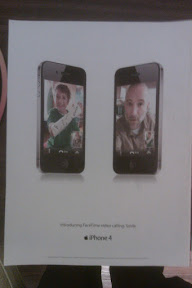
The Kindle hasn't quite made it into the mainstream consciousness yet--I've only seen one or two in the wild--so what better concept for an ad than to simply show the device itself at full size? The reader gets a good, uninterrupted look at the Kindle, with a human hand for scale, surrounded by the features Amazon wants to promote. I also give the designer credit for the text shown on the Kindle's screen, as Ellison's Invisible Man has a very strong prologue that draws the reader in. Displaying that text legibly on the screen of the Kindle in the ad encourages you to read it, and when it cuts off in the middle of a sentence you're left wanting more. The designer has thus created an unconscious connection between the Kindle and feelings of desire and unfulfillment, which is a very successful way to sell anything.

The iPhone, by contrast, is well established, and the ad doesn't need to explain the basics of the device. Instead, it draws attention to the new forward-facing camera by showing two iPhones facing each other. (Of course they're both cheated outwards for visibility, but they're supposed to be read as parallel.) We see the boy and the man talking to each other as if they were in the same room. iPhone's new video call feature, the ad says, is just as good as being face to face.







